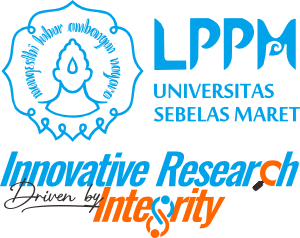Key words: Fusarium oxysporum, biological characterization, hypovirulence.
Widadi, Sri; Supyani
LPPM UNS, Penelitian, DP2M, Hibah Kompetitif Strategi Nasional, 2009
A filamentous fungus Fusarium oxysporum is the causal agent of many diseases on crops. The fungus has a broad host range including rice, horticulture crops, ornamental plants, and others. To date, there is no efficiently control method to the disease. So, the biological control to the fungus (such as by using antagonists, pathogens, and others) will be a priority. Fungi, like other eukaryotic organisms, can be infected by a number of viruses, and mycoviruses are found in all the major groups of fungi. Although mycoviruses are prevailing widely, fungal viruses isolated and studied are from only limited host fungi like the yeast Saccharomyces serevisiae, edible mushroom and phytopathogenic fungi that are of interests to the human society. Given the predicted huge number of fungal species (ca., 10,000 known species and much more unknown species), there should be a greater number of unrecognized viruses in the nature. Supports for this view come from recent extensive searches of field fungal isolates that show relatively high frequencies of virus infection, e.g., approximately 65%, 20%, and 2-28% for Helicobasidium mompa, Rosellinia necatrix and Cryphonectria parasitica, respectively. Some viruses infecting fungi reduce growth in aerial mycelia and severely repress virulence, so they could be developed as biological control agents against the fungi The aim of this research is to collect virulent viruses to F. oxysporum toward the development of viruses as biological control agents against the fungi. Morfological characterization was performed by culturing the fungus isolates on artificial medium followed by observating of their morphological parameters. Virulence assay was performed by inoculating fungus isolates on apples. Morfological characterization and virulence tests with apples revealed that the collected F. oxysporum isolates perform varied colony phenotype and virulence. The hypovirulent isolates such as A1, D4, and E4 perform slower in colony growth and weaker in virulence compared to the virulent isolate. The hypovirulent isolates are strongly indicated infected by viruses. The viruses will be further characterized and developed toward biological control agents.

